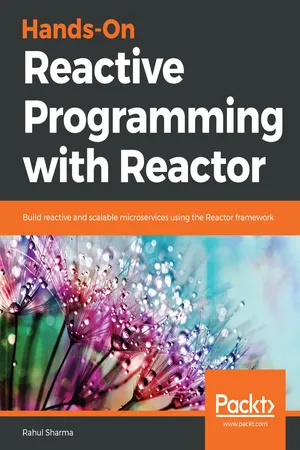
Hands-On Reactive Programming with Reactor
Build reactive and scalable microservices using the Reactor framework
- 250 pages
- English
- ePUB (mobile friendly)
- Available on iOS & Android
Hands-On Reactive Programming with Reactor
Build reactive and scalable microservices using the Reactor framework
About This Book
Discover how project Reactor enhances the reactive programming paradigm and allows you to build scalable asynchronous applications
Key Features
- Use reactive APIs, Flux, and Mono to implement reactive extensions
- Create concurrent applications without the complexity of Java's concurrent API
- Understand techniques to implement event-driven and reactive applications
Book Description
Reactor is an implementation of the Java 9 Reactive Streams specification, an API for asynchronous data processing. This specification is based on a reactive programming paradigm, enabling developers to build enterprise-grade, robust applications with reduced complexity and in less time. Hands-On Reactive Programming with Reactor shows you how Reactor works, as well as how to use it to develop reactive applications in Java.
The book begins with the fundamentals of Reactor and the role it plays in building effective applications. You will learn how to build fully non-blocking applications and will later be guided by the Publisher and Subscriber APIs. You will gain an understanding how to use two reactive composable APIs, Flux and Mono, which are used extensively to implement Reactive Extensions. All of these components are combined using various operations to build a complete solution.
In addition to this, you will get to grips with the Flow API and understand backpressure in order to control overruns. You will also study the use of Spring WebFlux, an extension of the Reactor framework for building microservices.
By the end of the book, you will have gained enough confidence to build reactive and scalable microservices.
What you will learn
- Explore benefits of the Reactive paradigm and the Reactive Streams API
- Discover the impact of Flux and Mono implications in Reactor
- Expand and repeat data in stream processing
- Get to grips with various types of processors and choose the best one
- Understand how to map errors to make corrections easier
- Create robust tests using testing utilities offered by Reactor
- Find the best way to schedule the execution of code
Who this book is for
If you're looking to develop event- and data-driven applications easily with Reactor, this book is for you. Sound knowledge of Java fundamentals is necessary to understand the concepts covered in the book.
Frequently asked questions
Information
Data and Stream Processing
- Filtering data
- Converting data
Technical requirements
- Java Standard Edition, JDK 8 or above
- IntelliJ IDEA IDE, 2018.1 or above
Generating data
Flux<Long> fibonacciGenerator = Flux.generate(() -> Tuples.<Long, Long>of(0L, 1L),(state, sink) -> {
if (state.getT1() < 0)
sink.complete();
else
sink.next(state.getT1());
return Tuples.of(state.getT2(), state.getT1() + state.getT2());
});
fibonacciGenerator.subscribe(t -> {
System.out.println(t);
}); - We create the Fibonacci series as Flux<Long> by using the Flux.generate() call. The API has a state and sink.
- The API takes a seed as Tuple [0 , 1]. It then emits the first argument of the pair by using the Sink.next() call.
- The API also generates the next Fibonacci number, by aggregating the pair.
- The publisher marks the stream as complete when we generate negative numbers. This is due to their being out of range of the long data type.
- We subscribe to the published numbers, then print the received number to the console. This is shown in the following screenshot:

Filtering data
- Select or reject data based on a given condition
- Select or reject a subset of the generated data

The filter() operator
fibonacciGenerator.filter(a -> a%2 == 0).subscribe(t -> { System.out.println(t); });
Table of contents
- Title Page
- Copyright and Credits
- Packt Upsell
- Contributors
- Preface
- Getting Started with Reactive Streams
- The Publisher and Subscriber APIs in a Reactor
- Data and Stream Processing
- Processors
- SpringWebFlux for Microservices
- Dynamic Rendering
- Flow Control and Backpressure
- Handling Errors
- Execution Control
- Testing and Debugging
- Assessments
- Other Books You May Enjoy